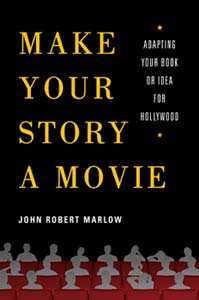Please welcome guest author John Robert Marlow with a post on writing a story with Hollywood appeal.
Too many authors write a book or other story, cross their fingers, and hope that one day Hollywood might come calling. But in the words of the world’s most successful filmmaker, James Cameron, “Hope is not a strategy.” Like it or not, if you want your story to become a movie, the first step is to make it film-friendly, long before Hollywood ever sees it.
Oscar-nominated producer Michael Nozik has produced dozens of films, many of them adaptations, including Quiz Show, The Motorcycle Diaries, Syriana, Love in the Time of Cholera, and The Next Three Days. He said, “One of the first things I ask, and I’m sure every other producer who looks at a piece of material asks, is this: is this thing a movie, or is this not a movie? Sometimes I’ll look at source material and think, this could be great, but I have no idea how to make it work as a movie, the story’s just too difficult to translate.”
Your job, as author of the book or other source material, is to make your story easy to translate. There are certain things Hollywood looks for in source material, which many books simply don’t have. (For simplicity, I’ll use “book” throughout, but all of these points apply equally to other story formats.) And while there’s not enough room in a blog post to cover all of them, I’ll touch on two of the most important: concept and structure.
Concept
First up is concept: you need a basic premise containing three things: the WHO, the GOAL, and the OBSTACLE. Who your story is about, what their goal is, and the nature of the obstacle that must be overcome if that goal is to be reached. Ideally you figure this out before you start writing, but if you’ve already completed the story, you can distill the concept afterward.
Either way, the end result is called a logline, your story summarized in ten seconds or less. If you think this can’t be done, think again. Here’s a logline I wrote for The Fugitive:
A fugitive doctor wrongly convicted of killing his wife struggles to prove his innocence while pursued by a relentless U.S. Marshal.
That covers the WHO (a fugitive doctor wrongly convicted of killing his wife), the GOAL (struggles to prove his innocence) and the OBSTACLE (a relentless U.S. Marshal), all in seven seconds. But why do you need this?
Two reasons: to make sure you have a cinematic concept and to be able to communicate that concept in the aforementioned ten seconds. Even screenwriters sometimes fail to realize the importance of this.
Terry Rossio is a screenwriting icon. His Pirates of the Caribbean, Zorro, Shrek, Aladdin, upcoming Lone Ranger and other adaptations have earned billions of dollars. One of his screenplays, Déjà Vu, sold for a record $5 million.
“Most aspiring screenwriters,” says Terry, “simply don’t spend enough time choosing their concept. It’s by far the most common mistake I see in spec scripts. The writer has lost the race right from the gate. Months — sometimes years — are lost trying to elevate a film idea that by its nature probably had no hope of ever becoming a movie.” The same is true of aspiring book authors. And if you want your book to become a movie, concept becomes doubly important.
Christopher Lockhart is the story editor at reigning Hollywood super agency WME (formerly William Morris Endeavor). “With hundreds of thousands of stories from new writers circulating around town,” he says, “there has to be some kind of vetting process. And concept is the quickest and easiest way to vet. If you don’t have representation or a solid recommendation, concept is the best way to catch someone’s attention — and in all cases, it’s helpful. Concept, concept, concept.”
In short, no one in Hollywood has time to read your story. Period. But — everyone in Hollywood reads loglines. When they find one that catches their attention, that’s when they ask to see a longer pitch, or the story itself. Then they’ll make time to read it.
(For more on this, see Building the Perfect Logline for Your Book, Screenplay, or Other Story.)
Structure
Despite occasional examples to the contrary, Hollywood wants good stories, well told. A good concept gets things off on the right foot, but it also needs to be well-executed throughout. And for Hollywood, a big part of that execution is structure.
Screenwriter/producer/director Jonathan Hensleigh’s credits include Armageddon and Die Hard 2 (an adaptation). “Any study of motion pictures and how they fare with the public over time,” he says, “reveals that there are certain aspects to script construction that need to be honored for a film to be commercial. For the most part; there are exceptions.
“The people who run studios are not stupid, and they know something about film and finance. They also know that a traditional three-act structure, with a beginning, middle, and end, is vastly more likely to be successful in the marketplace. Whereas something that, for example, just ends abruptly or is unresolved or unsatisfying is not going to be commercial. So those types of projects are rejected. I’ve heard it said that 90% of all commercially successful films are classically structured. But I’d say that percentage is too low.”
You want those 90% odds working for and not against you. If your story is already structured like a movie, it’s going to be that much easier for Hollywood to see it as a movie, instead of thinking, in producer Michael Nozik’s words, “the story’s just too difficult to translate.”
So — what is classical story structure? Boiled down to basics: three acts, with seven plot points. In proper story order, the plot points are: inciting incident, first act turn, midpoint, low point, second act turn, climax, and wrap-up. It sounds complicated and formulaic, but it’s not. Rather, it’s a recognition of patterns that have been used (consciously or otherwise) by storytellers for millennia. The following is a highly compressed explanation.
- The inciting incident is the event that throws a wrench into your main character’s everyday life, setting the story into motion.
- The first act turn is the point where your hero (as I’ll call the main character) realizes what he or she must do (the GOAL) and sets out to do it, taking action to reach that goal.
- The midpoint can be one of two things or both: a no-turning-back point for the hero, beyond which his actions cannot be undone, or the revelation (perhaps to the hero, perhaps only to the reader) of an as-yet-unsuspected element at work in the story.
- The low point is just that — the hero’s all-hope-is-lost moment, where he is as far as it seems possible to get from attaining the goal.
- Midpoint is followed closely by the second act turn where the hero rebounds from the seeming defeat of the low point and implements a new plan to achieve his goal.
- The climax happens when the hero (WHO) and OBSTACLE confront one another in the final showdown, the outcome of which will determine whether or not the hero succeeds in attaining the GOAL.
- The wrap-up is everything that follows after the climax has ended.
Once you think about it, this kind of story progression seems perfectly logical for pretty much every storytelling medium. Nevertheless, a great many aspiring storytellers are unaware of this classical structure and, consequently, fail to tell their stories in the way most likely to meet with commercial success in Hollywood and elsewhere.
Sometimes, one or more of these required elements will be completely absent. This hurts the storyteller’s chances not only with Hollywood, but with publishers as well. Story is story, regardless of medium.
Hollywood did not invent this; they merely codified it — because they have the greatest financial incentive to do so. When you’re plunking down millions or hundreds of millions of dollars to tell a story, you tend to sweat the details, to peek behind the curtain for a look at the structure holding up the beauty of a well-told story. And when you find that 90% of all commercially successful stories share the same structure, you want to see that structure firmly in place before hauling out your wallet.
Conclusion
None of this means your story can’t be chock full of other things as well, but these are some of the elements Hollywood considers crucial in its source material, including the books on which screenplays and movies are based.
To be sure, Hollywood is more comfortable reading screenplays and generally pays much more for scripts than it does for film rights to stories told in other formats (unless the source material is already hugely successful in its own right). As producer Michael Nozik notes, “studios are less willing to consider source material than finished screenplays based on the same material, and they’re willing to spend more when they can see it well executed as a screenplay, because you’re helping them get to the end zone — a finished film — quicker.” In short, when you have a screenplay, no one has to wonder how to “translate” the source material; you’ve done it for them.
Still, if you don’t have a screenplay to offer and are not interested in writing one (or hiring someone else to write one for you), the next best thing is telling your story in a way that makes it obviously cinematic. And while there’s more to that than concept and structure alone, these do form the foundation upon which all else is built, regardless of medium. And getting them right will help set you apart from the great mass of writers who, unknowingly, do not.
 About the Author: John Robert Marlow is an award-winning novelist, screenwriter, and adaptation consultant. He recently closed a Hollywood script deal, an adaptation he wrote and will executive produce, with an estimated budget of $60 million. John’s nonfiction articles have appeared in the Writer’s Digest annuals, The Writer, Writers’ Journal, Parade, The Huffington Post, and elsewhere. John’s new book, Make Your Story a Movie: Adapting Your Book or Idea for Hollywood (aff link), contains advice from authors, screenwriters, producers, directors and others whose movies have collectively earned over $50 billion and scores of Academy Award nominations. John blogs at makeyourstoryamovie.com.
About the Author: John Robert Marlow is an award-winning novelist, screenwriter, and adaptation consultant. He recently closed a Hollywood script deal, an adaptation he wrote and will executive produce, with an estimated budget of $60 million. John’s nonfiction articles have appeared in the Writer’s Digest annuals, The Writer, Writers’ Journal, Parade, The Huffington Post, and elsewhere. John’s new book, Make Your Story a Movie: Adapting Your Book or Idea for Hollywood (aff link), contains advice from authors, screenwriters, producers, directors and others whose movies have collectively earned over $50 billion and scores of Academy Award nominations. John blogs at makeyourstoryamovie.com.





